Chilean vs Iranian Community Comparison
COMPARE
Chilean
Iranian
Social Comparison
Social Comparison
Chileans
Iranians
8,759
SOCIAL INDEX
85.1/ 100
SOCIAL RATING
51st/ 347
SOCIAL RANK
9,682
SOCIAL INDEX
94.3/ 100
SOCIAL RATING
8th/ 347
SOCIAL RANK
Iranian Integration in Chilean Communities
The statistical analysis conducted on geographies consisting of 205,191,075 people shows a significant positive correlation between the proportion of Iranians within Chilean communities in the United States with a correlation coefficient (R) of 0.601. On average, for every 1% (one percent) increase in Chileans within a typical geography, there is an increase of 0.199% in Iranians. To illustrate, in a geography comprising of 100,000 individuals, a rise of 1,000 Chileans corresponds to an increase of 198.5 Iranians.
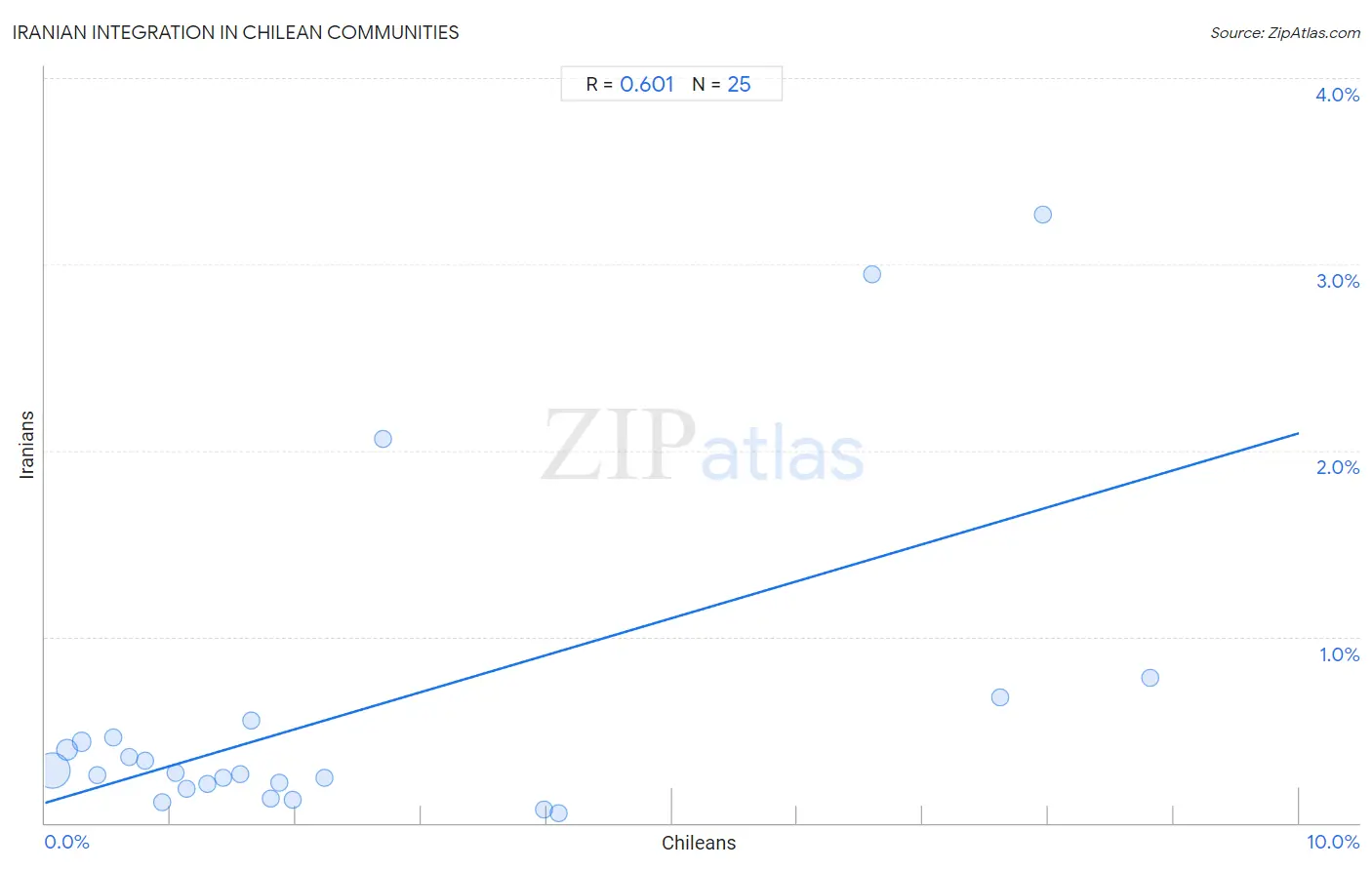
Chilean vs Iranian Income
When considering income, the most significant differences between Chilean and Iranian communities in the United States are seen in per capita income ($46,459 compared to $58,786, a difference of 26.5%), median male earnings ($56,973 compared to $70,648, a difference of 24.0%), and median family income ($108,429 compared to $133,839, a difference of 23.4%). Conversely, both communities are more comparable in terms of householder income under 25 years ($53,185 compared to $55,548, a difference of 4.4%), wage/income gap (26.3% compared to 29.7%, a difference of 13.0%), and median female earnings ($40,757 compared to $47,421, a difference of 16.4%).

| Income Metric | Chilean | Iranian |
| Per Capita Income | Exceptional $46,459 | Exceptional $58,786 |
| Median Family Income | Exceptional $108,429 | Exceptional $133,839 |
| Median Household Income | Exceptional $90,605 | Exceptional $109,835 |
| Median Earnings | Exceptional $48,504 | Exceptional $58,474 |
| Median Male Earnings | Exceptional $56,973 | Exceptional $70,648 |
| Median Female Earnings | Exceptional $40,757 | Exceptional $47,421 |
| Householder Age | Under 25 years | Exceptional $53,185 | Exceptional $55,548 |
| Householder Age | 25 - 44 years | Exceptional $99,900 | Exceptional $120,292 |
| Householder Age | 45 - 64 years | Exceptional $106,611 | Exceptional $129,350 |
| Householder Age | Over 65 years | Exceptional $63,957 | Exceptional $77,429 |
| Wage/Income Gap | Fair 26.3% | Tragic 29.7% |
Chilean vs Iranian Poverty
When considering poverty, the most significant differences between Chilean and Iranian communities in the United States are seen in receiving food stamps (11.0% compared to 7.9%, a difference of 38.4%), child poverty among girls under 16 (15.1% compared to 12.4%, a difference of 21.4%), and child poverty under the age of 16 (14.8% compared to 12.2%, a difference of 21.3%). Conversely, both communities are more comparable in terms of single male poverty (11.9% compared to 11.4%, a difference of 4.5%), female poverty among 18-24 year olds (19.1% compared to 20.1%, a difference of 4.9%), and single mother poverty (27.9% compared to 25.5%, a difference of 9.2%).
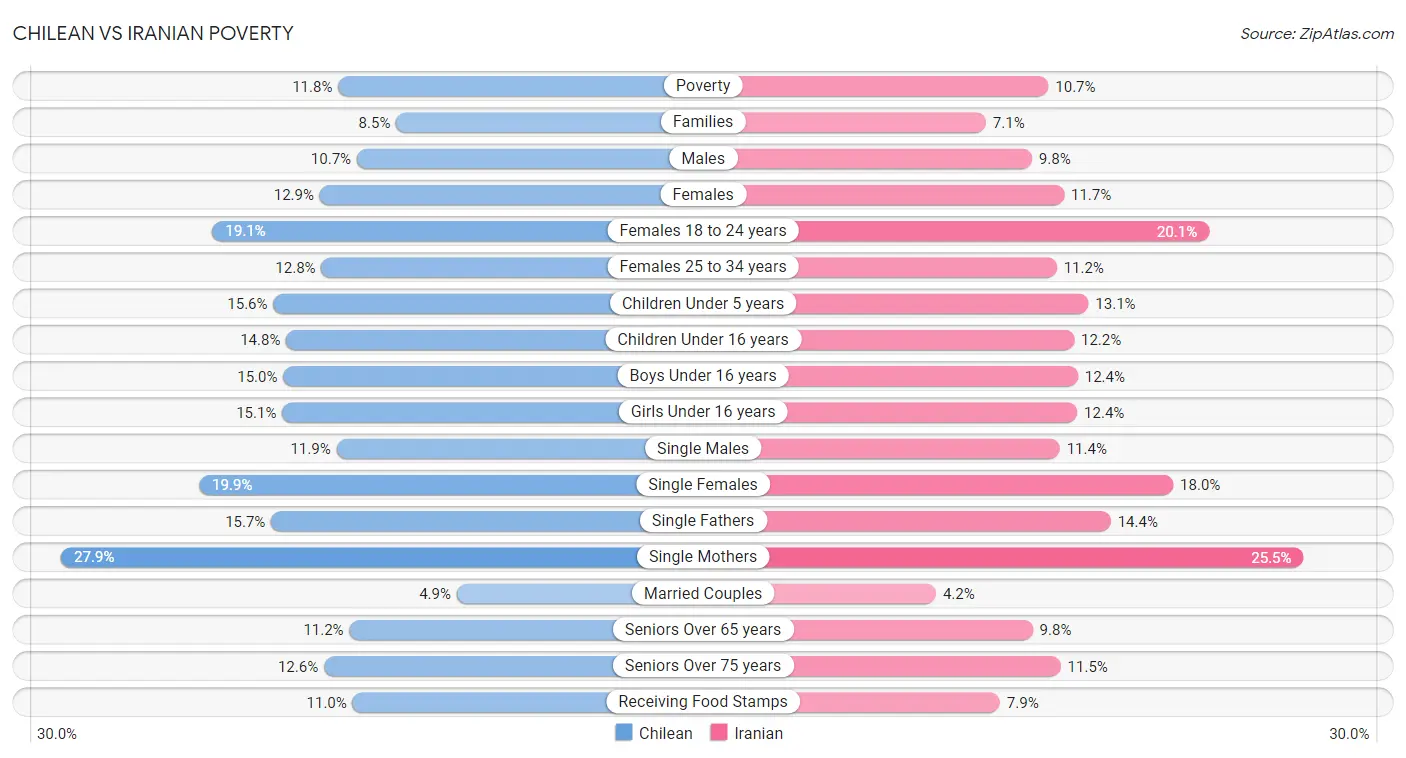
| Poverty Metric | Chilean | Iranian |
| Poverty | Excellent 11.8% | Exceptional 10.7% |
| Families | Excellent 8.5% | Exceptional 7.1% |
| Males | Excellent 10.7% | Exceptional 9.8% |
| Females | Excellent 12.9% | Exceptional 11.7% |
| Females 18 to 24 years | Exceptional 19.1% | Average 20.1% |
| Females 25 to 34 years | Exceptional 12.8% | Exceptional 11.2% |
| Children Under 5 years | Exceptional 15.6% | Exceptional 13.1% |
| Children Under 16 years | Exceptional 14.8% | Exceptional 12.2% |
| Boys Under 16 years | Exceptional 15.0% | Exceptional 12.4% |
| Girls Under 16 years | Exceptional 15.1% | Exceptional 12.4% |
| Single Males | Exceptional 11.9% | Exceptional 11.4% |
| Single Females | Exceptional 19.9% | Exceptional 18.0% |
| Single Fathers | Exceptional 15.7% | Exceptional 14.4% |
| Single Mothers | Exceptional 27.9% | Exceptional 25.5% |
| Married Couples | Excellent 4.9% | Exceptional 4.2% |
| Seniors Over 65 years | Fair 11.2% | Exceptional 9.8% |
| Seniors Over 75 years | Poor 12.6% | Exceptional 11.5% |
| Receiving Food Stamps | Excellent 11.0% | Exceptional 7.9% |
Chilean vs Iranian Unemployment
When considering unemployment, the most significant differences between Chilean and Iranian communities in the United States are seen in unemployment among women with children ages 6 to 17 years (8.8% compared to 8.0%, a difference of 9.9%), unemployment among seniors over 75 years (8.4% compared to 7.9%, a difference of 6.7%), and unemployment among women with children under 6 years (7.2% compared to 6.7%, a difference of 6.5%). Conversely, both communities are more comparable in terms of unemployment among seniors over 65 years (5.1% compared to 5.1%, a difference of 0.070%), male unemployment (5.0% compared to 5.0%, a difference of 0.11%), and unemployment among youth under 25 years (11.3% compared to 11.3%, a difference of 0.16%).
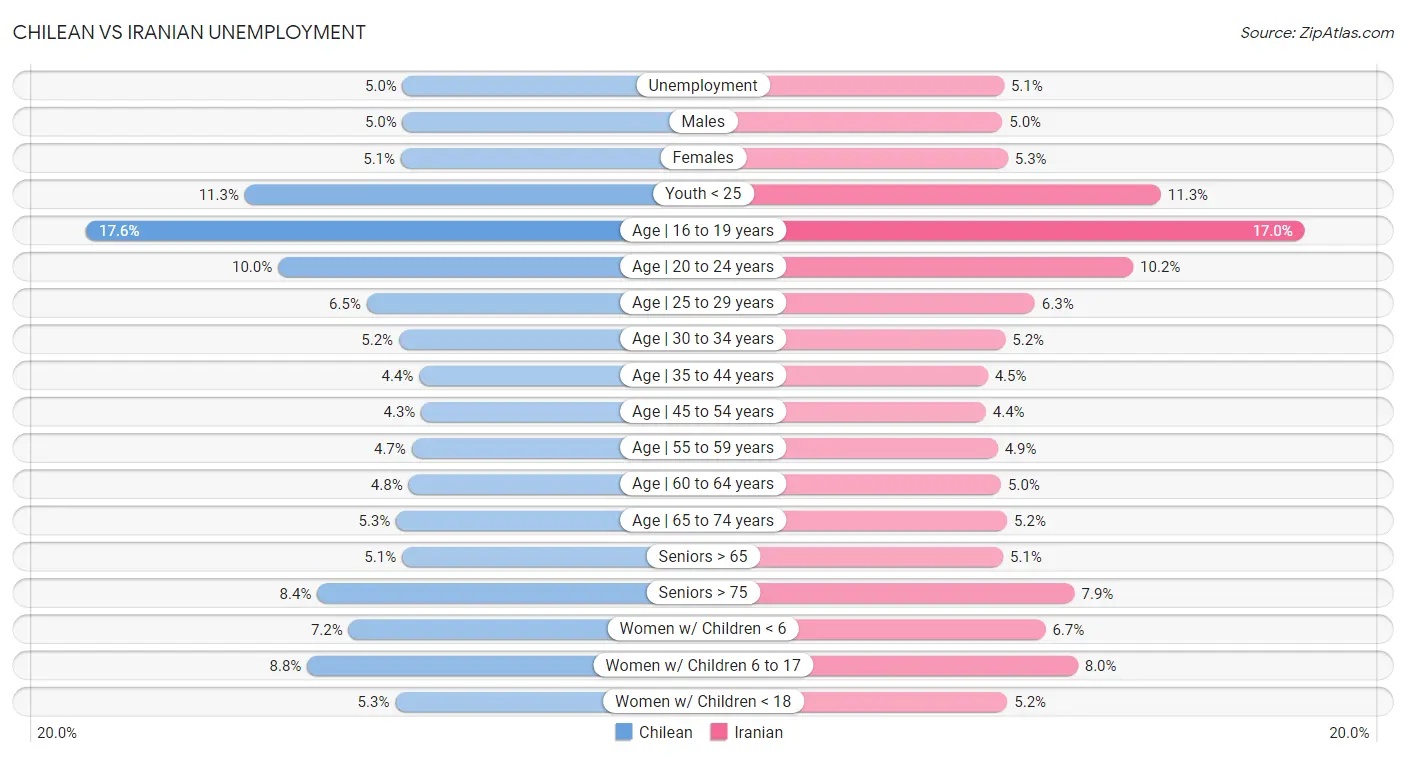
| Unemployment Metric | Chilean | Iranian |
| Unemployment | Exceptional 5.0% | Excellent 5.1% |
| Males | Exceptional 5.0% | Exceptional 5.0% |
| Females | Excellent 5.1% | Average 5.3% |
| Youth < 25 | Exceptional 11.3% | Exceptional 11.3% |
| Age | 16 to 19 years | Average 17.6% | Exceptional 17.0% |
| Age | 20 to 24 years | Exceptional 10.0% | Good 10.2% |
| Age | 25 to 29 years | Excellent 6.5% | Exceptional 6.3% |
| Age | 30 to 34 years | Exceptional 5.2% | Exceptional 5.2% |
| Age | 35 to 44 years | Exceptional 4.4% | Exceptional 4.5% |
| Age | 45 to 54 years | Exceptional 4.3% | Exceptional 4.4% |
| Age | 55 to 59 years | Exceptional 4.7% | Fair 4.9% |
| Age | 60 to 64 years | Good 4.8% | Tragic 5.0% |
| Age | 65 to 74 years | Good 5.3% | Exceptional 5.2% |
| Seniors > 65 | Excellent 5.1% | Excellent 5.1% |
| Seniors > 75 | Exceptional 8.4% | Exceptional 7.9% |
| Women w/ Children < 6 | Exceptional 7.2% | Exceptional 6.7% |
| Women w/ Children 6 to 17 | Excellent 8.8% | Exceptional 8.0% |
| Women w/ Children < 18 | Good 5.3% | Excellent 5.2% |
Chilean vs Iranian Labor Participation
When considering labor participation, the most significant differences between Chilean and Iranian communities in the United States are seen in in labor force | age 16-19 (35.8% compared to 33.0%, a difference of 8.3%), in labor force | age 20-24 (74.5% compared to 72.6%, a difference of 2.7%), and in labor force | age 30-34 (84.9% compared to 85.4%, a difference of 0.49%). Conversely, both communities are more comparable in terms of in labor force | age > 16 (66.0% compared to 66.0%, a difference of 0.010%), in labor force | age 20-64 (80.1% compared to 80.0%, a difference of 0.13%), and in labor force | age 25-29 (85.0% compared to 84.8%, a difference of 0.15%).

| Labor Participation Metric | Chilean | Iranian |
| In Labor Force | Age > 16 | Exceptional 66.0% | Exceptional 66.0% |
| In Labor Force | Age 20-64 | Exceptional 80.1% | Exceptional 80.0% |
| In Labor Force | Age 16-19 | Poor 35.8% | Tragic 33.0% |
| In Labor Force | Age 20-24 | Poor 74.5% | Tragic 72.6% |
| In Labor Force | Age 25-29 | Excellent 85.0% | Good 84.8% |
| In Labor Force | Age 30-34 | Excellent 84.9% | Exceptional 85.4% |
| In Labor Force | Age 35-44 | Exceptional 84.7% | Good 84.5% |
| In Labor Force | Age 45-54 | Exceptional 83.4% | Exceptional 83.2% |
Chilean vs Iranian Family Structure
When considering family structure, the most significant differences between Chilean and Iranian communities in the United States are seen in single mother households (6.1% compared to 5.0%, a difference of 23.3%), births to unmarried women (30.7% compared to 25.3%, a difference of 21.2%), and single father households (2.2% compared to 1.9%, a difference of 15.3%). Conversely, both communities are more comparable in terms of average family size (3.23 compared to 3.18, a difference of 1.5%), family households with children (28.1% compared to 27.7%, a difference of 1.5%), and family households (65.2% compared to 63.9%, a difference of 2.0%).

| Family Structure Metric | Chilean | Iranian |
| Family Households | Exceptional 65.2% | Poor 63.9% |
| Family Households with Children | Exceptional 28.1% | Excellent 27.7% |
| Married-couple Households | Exceptional 47.5% | Exceptional 49.0% |
| Average Family Size | Average 3.23 | Tragic 3.18 |
| Single Father Households | Exceptional 2.2% | Exceptional 1.9% |
| Single Mother Households | Good 6.1% | Exceptional 5.0% |
| Currently Married | Good 47.0% | Exceptional 48.6% |
| Divorced or Separated | Good 12.0% | Exceptional 10.8% |
| Births to Unmarried Women | Good 30.7% | Exceptional 25.3% |
Chilean vs Iranian Vehicle Availability
When considering vehicle availability, the most significant differences between Chilean and Iranian communities in the United States are seen in no vehicles in household (9.9% compared to 8.6%, a difference of 15.6%), 2 or more vehicles in household (56.1% compared to 58.1%, a difference of 3.5%), and 3 or more vehicles in household (19.7% compared to 20.1%, a difference of 2.1%). Conversely, both communities are more comparable in terms of 4 or more vehicles in household (6.4% compared to 6.5%, a difference of 0.97%), 1 or more vehicles in household (90.2% compared to 91.5%, a difference of 1.5%), and 3 or more vehicles in household (19.7% compared to 20.1%, a difference of 2.1%).

| Vehicle Availability Metric | Chilean | Iranian |
| No Vehicles Available | Excellent 9.9% | Exceptional 8.6% |
| 1+ Vehicles Available | Good 90.2% | Exceptional 91.5% |
| 2+ Vehicles Available | Excellent 56.1% | Exceptional 58.1% |
| 3+ Vehicles Available | Good 19.7% | Excellent 20.1% |
| 4+ Vehicles Available | Good 6.4% | Good 6.5% |
Chilean vs Iranian Education Level
When considering education level, the most significant differences between Chilean and Iranian communities in the United States are seen in doctorate degree (2.2% compared to 3.1%, a difference of 46.3%), professional degree (5.3% compared to 7.6%, a difference of 44.9%), and master's degree (16.9% compared to 22.3%, a difference of 31.5%). Conversely, both communities are more comparable in terms of nursery school (98.0% compared to 98.2%, a difference of 0.23%), kindergarten (98.0% compared to 98.2%, a difference of 0.23%), and 1st grade (97.9% compared to 98.2%, a difference of 0.23%).
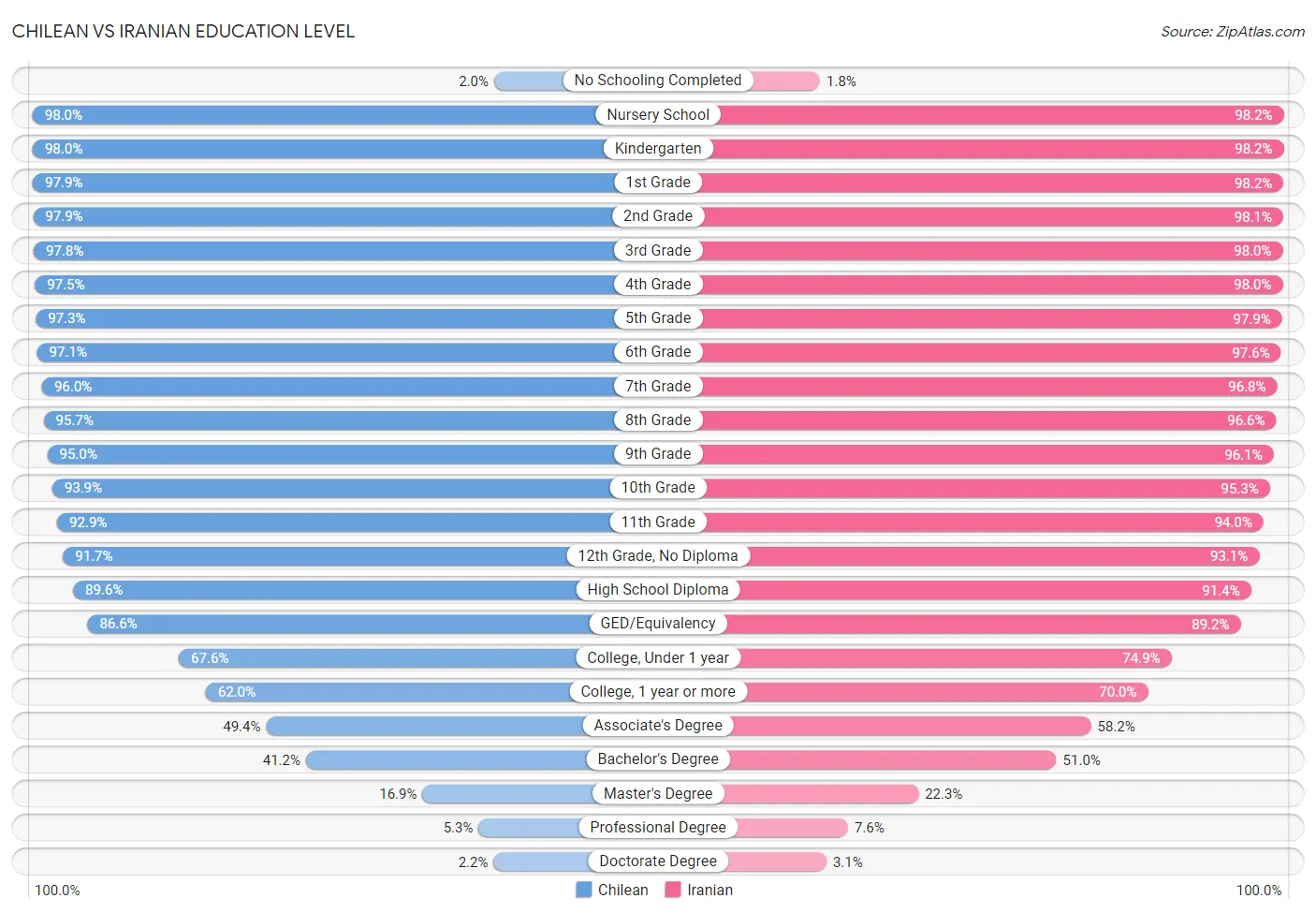
| Education Level Metric | Chilean | Iranian |
| No Schooling Completed | Good 2.0% | Exceptional 1.8% |
| Nursery School | Average 98.0% | Exceptional 98.2% |
| Kindergarten | Average 98.0% | Exceptional 98.2% |
| 1st Grade | Average 97.9% | Exceptional 98.2% |
| 2nd Grade | Average 97.9% | Exceptional 98.1% |
| 3rd Grade | Average 97.8% | Exceptional 98.0% |
| 4th Grade | Average 97.5% | Exceptional 98.0% |
| 5th Grade | Average 97.3% | Exceptional 97.9% |
| 6th Grade | Average 97.1% | Exceptional 97.6% |
| 7th Grade | Average 96.0% | Exceptional 96.8% |
| 8th Grade | Average 95.7% | Exceptional 96.6% |
| 9th Grade | Good 95.0% | Exceptional 96.1% |
| 10th Grade | Good 93.9% | Exceptional 95.3% |
| 11th Grade | Excellent 92.9% | Exceptional 94.0% |
| 12th Grade, No Diploma | Excellent 91.7% | Exceptional 93.1% |
| High School Diploma | Good 89.6% | Exceptional 91.4% |
| GED/Equivalency | Excellent 86.6% | Exceptional 89.2% |
| College, Under 1 year | Exceptional 67.6% | Exceptional 74.9% |
| College, 1 year or more | Exceptional 62.0% | Exceptional 70.0% |
| Associate's Degree | Exceptional 49.4% | Exceptional 58.2% |
| Bachelor's Degree | Exceptional 41.2% | Exceptional 51.0% |
| Master's Degree | Exceptional 16.9% | Exceptional 22.3% |
| Professional Degree | Exceptional 5.3% | Exceptional 7.6% |
| Doctorate Degree | Exceptional 2.2% | Exceptional 3.1% |
Chilean vs Iranian Disability
When considering disability, the most significant differences between Chilean and Iranian communities in the United States are seen in disability age under 5 (1.3% compared to 1.0%, a difference of 24.2%), disability age 35 to 64 (10.2% compared to 8.7%, a difference of 18.2%), and disability age 5 to 17 (5.4% compared to 4.6%, a difference of 16.9%). Conversely, both communities are more comparable in terms of disability age over 75 (46.5% compared to 45.9%, a difference of 1.3%), self-care disability (2.3% compared to 2.3%, a difference of 2.6%), and cognitive disability (17.0% compared to 16.5%, a difference of 3.1%).
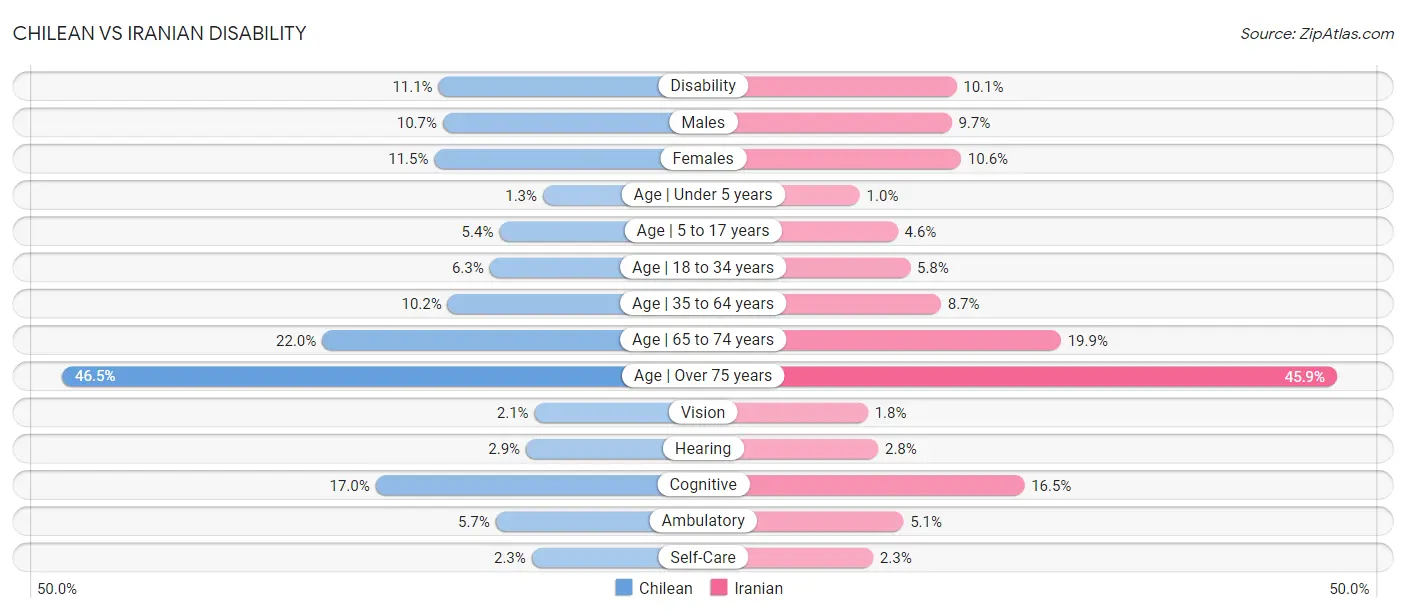
| Disability Metric | Chilean | Iranian |
| Disability | Exceptional 11.1% | Exceptional 10.1% |
| Males | Exceptional 10.7% | Exceptional 9.7% |
| Females | Exceptional 11.5% | Exceptional 10.6% |
| Age | Under 5 years | Poor 1.3% | Exceptional 1.0% |
| Age | 5 to 17 years | Exceptional 5.4% | Exceptional 4.6% |
| Age | 18 to 34 years | Exceptional 6.3% | Exceptional 5.8% |
| Age | 35 to 64 years | Exceptional 10.2% | Exceptional 8.7% |
| Age | 65 to 74 years | Exceptional 22.0% | Exceptional 19.9% |
| Age | Over 75 years | Exceptional 46.5% | Exceptional 45.9% |
| Vision | Exceptional 2.1% | Exceptional 1.8% |
| Hearing | Excellent 2.9% | Exceptional 2.8% |
| Cognitive | Excellent 17.0% | Exceptional 16.5% |
| Ambulatory | Exceptional 5.7% | Exceptional 5.1% |
| Self-Care | Exceptional 2.3% | Exceptional 2.3% |